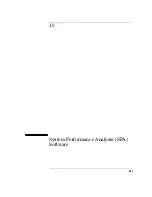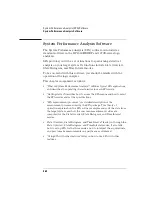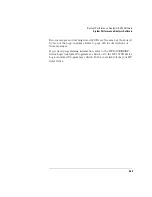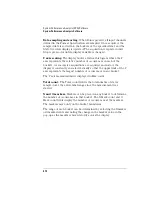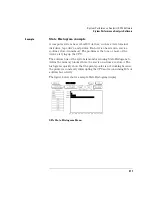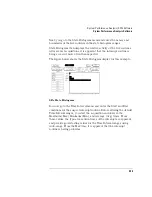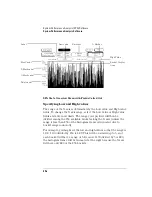
374
System Performance Analysis (SPA) Software
System Performance Analysis Software
State Histogram mode
State Histogram mode displays relative activity of ranges of a specified
label. The ranges can also be compared to activity on the rest of the
label not defined in the ranges. Data qualification is possible with State
Histogram, so data can be filtered during acquisition.
Data sampling and sorting.
When Run is pressed, all input channels
defined in the Format Specification are sampled. Once acquired, each
sample in the acquisition is compared to each defined range. If the
sample value is inclusively within the range and if the range is on, the
count for that range is incremented, then the State Histogram display
is updated. The acquisition is repeated until Stop is pressed or until a
display variable is changed.
The histogram is displayed on a percentage scale, and each bar
represents the fraction of all samples in that range. For example, if a
bar reaches the 40% value on the display, then the range for that bar
contains 40% of all the samples displayed. If the total percentages of all
bars equals greater than 100%, then ranges have been overlapped and
data has been counted twice.
State Histogram vs. State Overview.
State Histogram is similar to
State Overview, but there are key differences between the two modes.
State Overview shows relative distribution of activity over a single
contiguous range of a label. State Histogram also allows several non-
contiguous ranges of a label to be defined.
State Overview requires minimal setup, and provides a quick overview
of system activity. State Histogram requires more setup, but provides
greater resolution and measurement flexibility.
Summary of Contents for 1670E Series
Page 6: ...6 In This Book...
Page 26: ...26 Contents...
Page 27: ...27 Section 1 Logic Analyzer...
Page 28: ...28...
Page 29: ...29 1 Logic Analyzer Overview...
Page 39: ...39 2 Connecting Peripherals...
Page 49: ...49 3 Using the Logic Analyzer...
Page 72: ...72 Using the Logic Analyzer The Inverse Assembler...
Page 73: ...73 4 Using the Trigger Menu...
Page 101: ...101 5 Using the Oscilloscope...
Page 151: ...151 6 Using the Pattern Generator...
Page 199: ...199 7 Triggering Examples...
Page 237: ...237 8 File Management...
Page 249: ...249 9 Logic Analyzer Reference...
Page 360: ...360 Logic Analyzer Reference The Compare Menu...
Page 361: ...361 10 System Performance Analysis SPA Software...
Page 397: ...397 11 Logic Analyzer Concepts...
Page 430: ...430 Logic Analyzer Concepts The Analyzer Hardware Oscilloscope board theory Oscilloscope board...
Page 439: ...439 12 Troubleshooting the Logic Analyzer...
Page 455: ...455 13 Specifications...
Page 471: ...471 14 Operator s Service...
Page 479: ...479 Operator s Service Troubleshooting Troubleshooting Flowchart 2...
Page 491: ...491 Section 2 LAN...
Page 492: ...492...
Page 493: ...493 15 Introducing the LAN Interface...
Page 497: ...497 16 Connecting and Configuring the LAN...
Page 506: ...506 Connecting and Configuring the LAN Connecting and Configuring the LAN...
Page 507: ...507 17 Accessing the Logic Analyzer File System Using the LAN...
Page 515: ...515 18 Using the LAN s X Window Interface...
Page 527: ...527 19 Retrieving and Restoring Data Using the LAN...
Page 539: ...539 20 Programming the Logic Analyzer Using the LAN...
Page 546: ...546 Programming the Logic Analyzer Using the LAN Programming the Logic Analyzer Using the LAN...
Page 547: ...547 21 LAN Concepts...
Page 555: ...555 22 Troubleshooting the LAN Connection...
Page 580: ...580 Troubleshooting the LAN Connection Getting Service Support...
Page 581: ...581 Section 3 Symbol Utility...
Page 582: ...582...
Page 583: ...583 23 Symbol Utility Introduction...
Page 588: ...588 Symbol Utility Introduction Symbol Utility Introduction...
Page 589: ...589 24 Getting Started with the Symbol Utility...
Page 597: ...597 25 Using the Symbol Utility...
Page 609: ...609 26 Symbol Utility Features and Functions...


